Motivation
Estimating the disturbance or clutter covariance is a centrally important problem in radar space-time adpative processing (STAP) since since estimation of the disturbance or interference covariance matrix plays a central role on radar target detection in the presence of clutter, noise and a jammer. Traditional maximum likelihood (ML) estimators are effective when homogeneous (target free) training data is abundant. However, large number of homogeneous training samples are generally not available in practice because of practical limitations and system considerations. The problem has been exacerbated by recent advances that have led to more antenna elements (J) and higher temporal resolution (P) time epochs resulting in a large dimension (N = JP).
Robust Covariance Estimation
We address the aforementioned challenges by exploiting physically inspired constraints into ML estimation. Unlike unconstrained estimators, a vast majority of constrained radar STAP estimators are iterative and expensive numerically, which prohibits practical deployment. We focus on breaking this classical trade-off between computational tractability and desirable performance measures. In particular, we exploit both the structure of the disturbance covariance and importantly the knowledge of the clutter rank to yield a new rank constrained maximum likelihood (RCML) estimator of clutter/disturbance covariance. We demonstrate that the rank-constrained estimation problem can in fact be cast in the framework of a tractable convex optimization problem, and derive closed form expressions for the estimated covariance matrix. In addition, we derive a new covariance estimator for STAP that jointly considers a Toeplitz structure and a rank constraint on the clutter component. Our proposed solution leverages the rank constrained ML estimator (RCML) of structured covariances to build a computationally friendly approximation that involves a cascade of two closed form solutions. As shown in Figure 1, the EASTR solution involves a cascade of two steps in which a closed-form solution is available in each step and hence remains amenable for implementation in practical radar systems.

Flow chart for EASTR. The first part shows that each training sample x comes from antenna arrays consisting of J independent antenna channels and P time taps. We obtain the RCML solution (the first block) from N observed training samples. The solution is a RCML solution but not Toeplitz. Then, we adjust the eigenvalues of the RCML solution by the rank-preserving Toeplitz approximation algorithm (the second block) to obtain exact or approximation of Toeplitz covariance matrix.
Radar Waveform Design
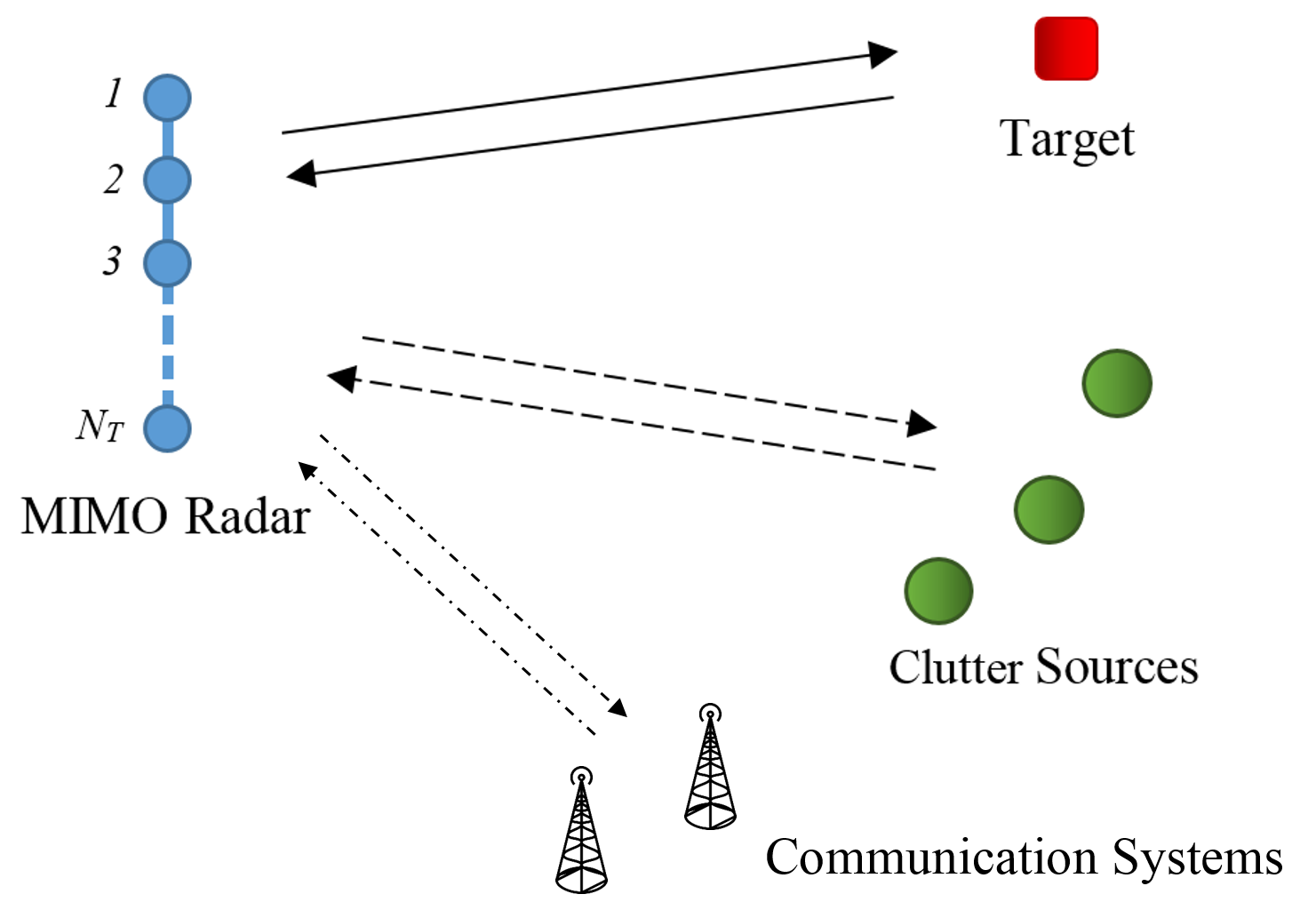
Figure 2. Illustration of MIMO radar and interferences scenario
We design a radar transmit waveform that maximizes the radar SINR under the important practical constraints of constant modulus and waveform similarity as well as the spectral interference constraint. We develop a new analytical approach that involves solving a sequence of convex Quadratically Constrained Quadratic Programing (QCQP) problems, which we prove converges to a sub-optimal solution. Because an improvement in SINR results via solving each problem in the sequence, we call the method Successive QCQP Refinement (SQR). We evaluate SQR against other candidate techniques with respect to SINR performance, beampattern and pulse compression properties in a variety of scenarios. Results show that SQR outperforms state of the art methods that also employ constant modulus and/or similarity constraints while being computationally less burdensome.
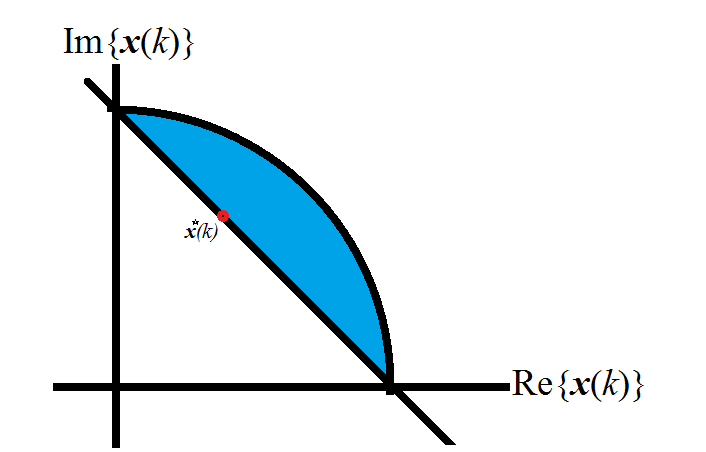 (a) |
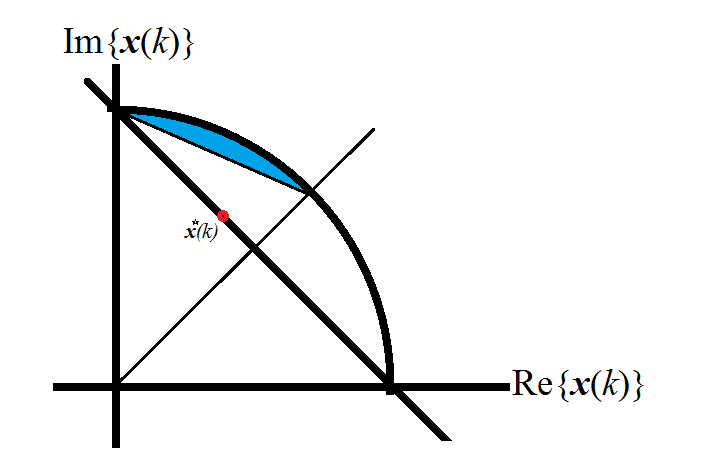 (b) |
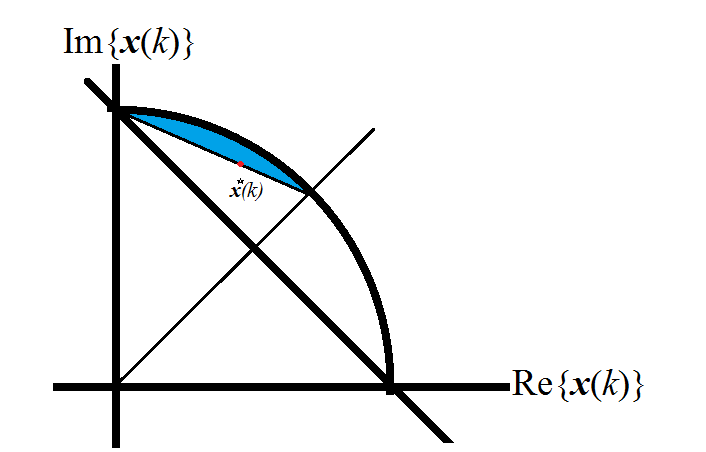 (c) |
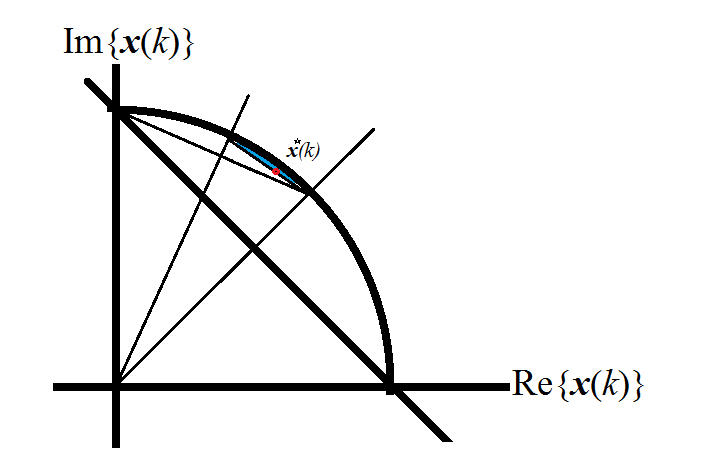 (d) |
Figure 3. Illustration of the successive approximation: (a) The convex hull is the blue area. (b) The solution point of the convex problem in red. Now, we consider only the upper half of the similarity constraint and solve again. (c) Sconced refinement. (d) Third refinement, here solution in the third refinement is very close to unity.
In addition, we also address the problem of designing a beampattern for Multiple-Input-Multiple-Output (MIMO) radar, which in turn is determined by the transmit waveform. A new approach is proposed in our work, which involves solving the hard non-convex problem of beampattern design using a sequence of convex equality constrained Quadratic Programs (QP), each of which has a closed form solution. The converged solution achieves constant modulus and satisfies the Karush–Kuhn–Tucker (KKT) optimality conditions, which we prove formally is possible under mild and realistic assumptions. We evaluate the proposed successive closed forms (SCF) algorithm against state-of-the-art MIMO beampattern design techniques and show that SCF breaks the trade-off between desirable performance and the associated computation cost.
Related Publications
K. A. Alhujaili, X. Yu, G. Cui and V. Monga, "Spectrally Compatible MIMO Radar Beampattern Design Under Constant Modulus Constraints", IEEE Transactions on Aerospace and Electronic Systems, vol 56, number 6, pp 4749-4766, December 2020.
X. Yu, K. A. Alhujaili, G. Cui and V. Monga, "MIMO Radar Waveform Design in the Presence of Multiple Targets and Practical Constraints", IEEE Transactions on Signal Processing, volume 68, pp. 1974-1989, 2020.
K. A. Alhujaili, V. Monga and M. Rangaswamy, "Quartic Gradient Descent for Tractable Radar Slow-Time Ambiguity Function (STAF) Shaping", IEEE Transactions on Aerospace and Electronic Systems , volume 56, issue 2, pp. 1474-1489, August 2019.
K. A. Alhujaili, V. Monga and M. Rangaswamy, "Transmit MIMO Radar Beampattern Design Via Optimization on the Complex Circle Manifold", in IEEE Transactions on Signal Processing, vol. 67, no. 13, pp. 3561-3575, July, 2019.
B. Kang, O. Aldayel, V. Monga and M. Rangaswamy, "Spatio-spectral Radar Beampattern Design for Co-existence with Wireless Communication Systems", IEEE Transactions on Aerospace and Electronic Systems, volume 55, issue 2, pages 644-657, April 2019.
B. Kang, V. Monga, and M. Rangaswamy, "Rank constrained ML estimation of structured covariance matrices," IEEE Transactions on Aerospace and Electronic Systems, volume 50, issue 1, pages 501-516, January 2014.[IEEE Xplore]
B. Kang, V. Monga, and M. Rangaswamy, "Computationally Efficient Toeplitz Approximation of Structured Covariance Under a Rank Constraint," IEEE Transactions on Aerospace and Electronic Systems, volume 51, issue 1, January 2015. [IEEE Xplore]
B. Kang, V. Monga, M. Rangaswamy, and Y. Abramovich, "An Expected Likelihood Approach for Determining Constraints in Covariance Estimation," IEEE Transactions on Aerospace and Electronic Systems,, volume 52, issue 5, pages 2139-2156, October 2016. [IEEE Xplore]
V. Monga and M. Rangaswamy, "Rank-constrained maximum likelihood (ML) estimation of clutter covariance with applications," in Proceedings of the IEEE International Radar Conference, Atlanta, GA, May 2012. [IEEE Xplore]
B. Kang, V. Monga, and M. Rangaswamy, "On the practical merits of the rank constrained ML estimator," in Proceedings of the IEEE International Radar Conference, Ottawa, Canada, May 2013. [IEEE Xplore]
B. Kang, V. Monga, and M. Rangaswamy, "EASTR: Efficient Approximation of Structured covariance under joint Toeplitz and Rank constraints," in Proceedings of the IEEE Asilomar Conference on Signals, Systems and Computers, Pacific Grove, CA, November 2013. [IEEE Xplore]
B. Kang, V. Monga, and M. Rangaswamy, "Constrained ML estimation of structured covariance matrices with applications in radar STAP," IEEE 5th International Workshop on Computational Advances in Multi-Sensor Adaptive Processing (CAMSAP), December 2013. [IEEE Xplore]
B. Kang, V. Monga, and M. Rangaswamy, "Estimation of Structured Covariance Matrices for radar STAP under Practical Constraints," in Proceedings of the IEEE International Radar Conference, Cincinnati, OH, May 2014. Winner of the Best Student Paper Award. [IEEE Xplore]
B. Kang, V. Monga, M. Rangaswamy, and Y. Abramovich, "Automatic rank estimation for practical STAP covariance estimation via an expected likelihood approach," in Proceedings of the IEEE International Radar Conference, Washington DC, May 2015. [IEEE Xplore]
O. Aldayel, V. Monga, and M. Rangaswamy, "Successive QCQP Refinement for MIMO Radar Waveform Design Under Practical Constraints," IEEE Transactions on Signal Processing, volume 64, no. 14, pages 3760-3773, July 2016. [IEEE Xplore]
O. Aldayel, V. Monga, and M. Rangaswamy, "Tractable Transmit MIMO Beampattern Design under a Constant Modulus Constraint," IEEE Transactions on Signal Processing, volume 65, issue 10, pages 2588-2599, May 2017. [IEEE Xplore]
O. Aldayel, V. Monga, and M. Rangaswamy, "SQR: Successive QCQP Refinement for MIMO Radar Waveform Design," in Proceedings of the IEEE Asilomar Conference on Signals, Systems and Computers, Pacific Grove, CA, November 2015. Finalist for the Best Student Paper Award. [IEEE Xplore]
O. Aldayel, V. Monga, and M. Rangaswamy, "Tractable MIMO Beampattern Design Under Constant Modulus Waveform Constraint," in Proceedings of the IEEE International Radar Conference, Philadelphia, PA, May 2016. [IEEE Xplore]